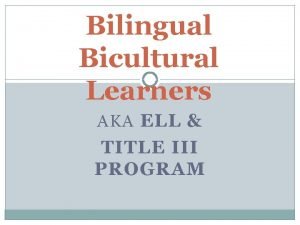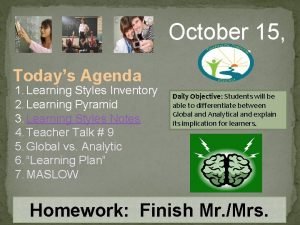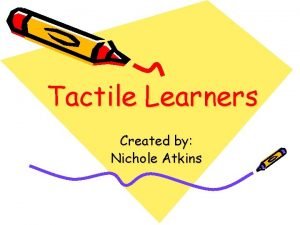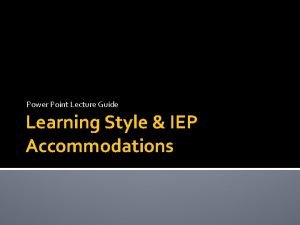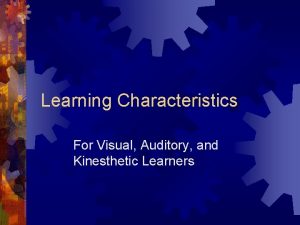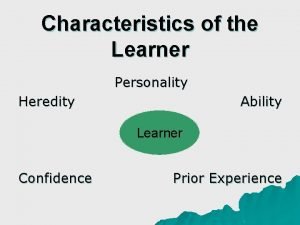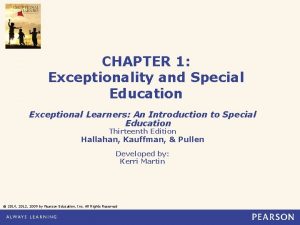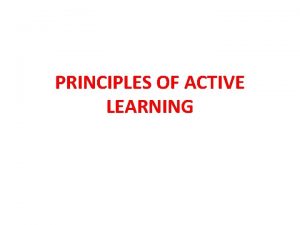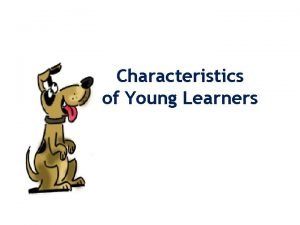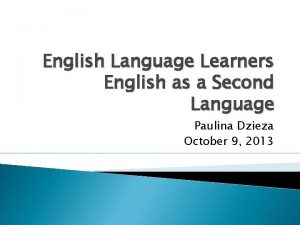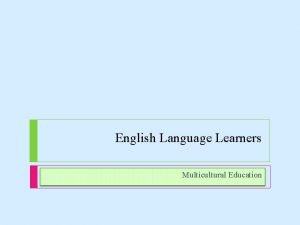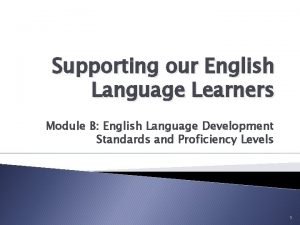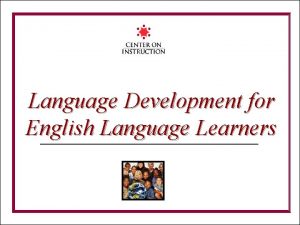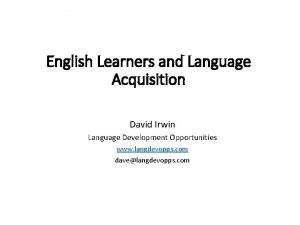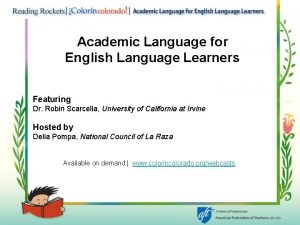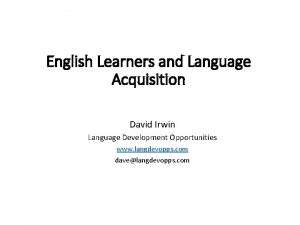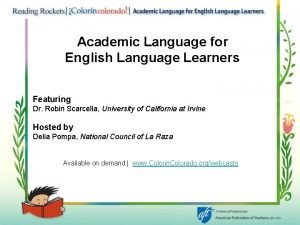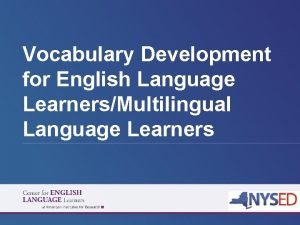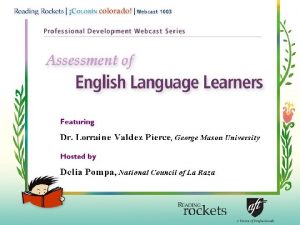English Language Learners What is an English Language



















- Slides: 19

English Language Learners

What is an English Language Learner? ► An EL is a K-12 student who, based on objective assessment, has not developed listening, speaking, reading, and writing proficiencies in English sufficient for participation in the regular school program. These students are sometimes referred to as Limited English Proficient (LEP).

Understanding Second Language Learning ► It is not simple or easy for children to learn a second language -ELL’s work even harder to acquire a second language; the first language is a process that involves much a ► learning younger child’s day. Young children need time to learn new language -research shows that older children/adults have the ability to learn vocab and grammar of a new lang. faster; this is because they already have developed learning strategies. ► Fluency on the playground does not necessarily mean proficiency in the classroom -a child who is fluent on the playground is likely to require 4 -6 yrs to acquire the level of proficiency needed for successful academic learning.

Understanding Second Language Learning ► Children learn a second language in different ways -outgoing children may imitate phases and expressions very early w/out hesititation; others may observe quietly until they are aware of what to say, but these children may be at different proficiency levels ► Silence is sometimes needed -some learners need to focus more on learning than speaking; some students may to “tune out” from the constant effort of listening and speaking their new language ► Errors can indicate progress -errors sometimes happen when learners are trying out new grammatical structures; teachers should give children time to answer instead of moving to another child too quickly.

Instruction in the active learning classroom ► The classroom should be predictable and accepting of all students. -teachers can increase comfort levels through structured class rules and activity patterns, explicit expectation, genuine care and concern for each student. ► Instructional activities should maximize opportunities for language use. -each student, at their own level of proficiency, should have opportunities to communicate meaningfully in their own way. ► Instructional tasks should involve students as active participants. -students can learn more effectively when they can play a role in their own learning

Instruction in the active learning classroom ► Instructional interactions should provide support for student understanding. -teachers should ensure students understand concepts and materials being presented. For ELL students, this includes providing support for student’s understanding of instruction presented in English ► Instructional content should utilize student diversity. -incorporating diversity into the classroom provides ELL students with social support and offers other students a chance to validate different cultural perspectives. Also, information relevant to ELL students’ backgrounds assist them in understanding content.

What challenges will you face as a teacher? ► Communication! ► Lack of time to teach English Languages Learners ► Variability in student academic needs/levels ► Encouraging/motivatin g ELLs ► Lack of teaching tools/ESL knowledge

Advice for Colleagues: The Importance in Understanding Culture ► First and foremost find out as much about their cultural history as you can o for example: previous school experience, where they came from, why they left ► Differences in cultures can affect the way in which children interact in the classroom o Some cultures view it as disrespectful to ask the teacher questions

Advice for Colleagues: Creating a Classroom Environment Beneficial to ELL Students ► Create an environment in the classroom that is predictable and welcoming to all students § this will reduce anxiety in ELL students ► Use repetition when explaining procedures or giving directions ► Label things in the classroom so ELL’s can pick up on words and the language visually as well as verbally

Advice for Colleagues: Helping ELL’s Learn ► Try to use thematic integration when teaching § Tie together subjects in literature, math, social studies and science ► Spend more time on learning fewer concepts

Advice for Colleagues: Helping ELL’s Learn ► Don’t assume that every student has had the same common experiences as most text books do ► When discussing a topic specific to our culture or history, use a broader discussion topic to lead up to that. § Example: when talking about the Civil war talk about general wars and disputes first, or what a civil war is § This gives more general background to ELL’s and allows them to possibly relate the topic to their prior experiences.

Advice for Colleagues: Preparing Curriculum with ELL’s in Mind ► Provide ELL’s with a list of essential vocabulary words prior to a lesson so that they are able to look up words and translate them prior to the lesson. ► Make ► Use use of visual aids hands on activities whenever possible ► ELL’s benefit from cooperative learning § Give an ELL a learning buddy

Parent Involvement At the start of school, hold an in school session to have parents complete forms. Try to have Translators should be available. ► This is a good opportunity to share information on school supplies and other expectations, and enlist parents and guardians as school/classroom volunteers. ► Providing forms in the family's Native language is very ► Hold Parent Teacher conferences ► Try your best to get parents involved. Parent nights are a great way to engage family members in school activities. To build rapport between the parents and ► teachers, parents could be asked if they would be willing to give the teachers lessons on ethnic dancing or music or cooking popular ethnic recipes. ►

How to reach out to parents ► Use ► their preferred language Find a fully bilingual interpreter Translate the written communications that you send home Learn some of the language yourself. Put parents in touch with bilingual staff. ► Educate parents on the U. S. school system ► Arrange home and community visits

Cultural Awareness ► It is useful to have written guidebooks available to staff covering relevant program policies and procedures and cultural issues related to the nationalities served. A district with significant immigrant populations might think of having designated liaison staff for such groups. With concerted efforts, liaisons will usually win the confidence of the community. ► Generally students from other countries including Mexico, may have varied educational experiences. ► In some cultures, the notion of parents going to school for parent/teacher conferences is not a common occurrence. As such, there may be a natural hesitancy on the parents' part to attend conferences with the teacher or positively receive telephone calls from school personnel. ►

What if my students' parents speak only speaks their native language and does not know how to read? ► Even if your students' parents cannot read, there are many ways they can develop their children's oral language skills and support their literacy efforts. Here a few : ► Homework help ► Direct help ► Keep tabs ► Provide good work space ► Find a tutor ideas

Online Parent Resources http: //www. helpforschools. com/ELLKBase/tips/Guide_ Understanding. Hispanic. Stu dents. shtml ► http: //www. ncela. gwu. edu /pubs/classics/pig/08 paren tal. htm ► ► http: //www. colorincolorad o. org/reachingout/outreac h. php

Movie Clip – what it’s like for an ELL ► www. celt. sunysb. edu/ell/default. php

Resources ► http: //www. ncela. gwu. edu/pubs/pig 19. htm ► http: //www. helpforschools. com/ELLKBase/ ► http: //www. cftl. org/centerviews/july 05. html ► http: //www. cde. ca. gov/sp/el ► http: //www. celt. sunysb. edu/ell/tips. php#who_Are _They ► http: //www. educationworld. com/a_curr/shore 073. shtml
 Audioize
Audioize English language learners
English language learners Reading strategies for english language learners
Reading strategies for english language learners Equal protection for english language learners
Equal protection for english language learners Teaching young learners english
Teaching young learners english Global vs analytical learners
Global vs analytical learners Grammar examples
Grammar examples Facts about tactile learners
Facts about tactile learners Meaning of remedial teaching
Meaning of remedial teaching Global vs analytical learners
Global vs analytical learners Auditory learners characteristics
Auditory learners characteristics Remarks on lazy and eager learning
Remarks on lazy and eager learning Kinesthetic imagery
Kinesthetic imagery When is cognitivism beneficial for learners
When is cognitivism beneficial for learners Domain 3 diversity of learners
Domain 3 diversity of learners Code of ethics resolution no. 435
Code of ethics resolution no. 435 Inheritance characteristics
Inheritance characteristics Exceptional learners: an introduction to special education
Exceptional learners: an introduction to special education Principles of active learning
Principles of active learning Young learners characteristics
Young learners characteristics

